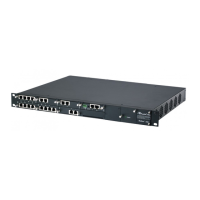Version 6.4 275 March 2012
SIP User's Manual 18. GW and IP to IP
4. Click Submit to apply your changes.
5. To save the changes to flash memory, see 'Saving Configuration' on page 482.
Table 18-13: Outbound IP Routing Table Parameters
Parameter Description
Web/EMS: Tel to IP
Routing Mode
[RouteModeTel2IP]
Determines whether to route received calls to an IP destination before or after
manipulation of the destination number.
[0] Route calls before manipulation = Calls are routed before the number
manipulation rules are applied (default).
[1] Route calls after manipulation = Calls are routed after the number
manipulation rules are applied.
Notes:
This parameter is not applicable if outbound proxy routing is used.
For number manipulation, see 'Configuring Number Manipulation Tables'
on page 256.
Web: Src. IPGroupID
EMS: Source IP
Group ID
Defines the IP Group from where the incoming IP call is received. Typically,
the IP Group of an incoming INVITE is determined according to the Inbound
IP Routing Table’.
Notes:
This parameter is applicable only for IP-to-IP routing.
To denote all IP Groups, leave this field empty.
If this IP Group has a Serving IP Group, then all calls from this IP Group
are sent to the Serving IP Group. In such a scenario, this routing table is
used only if the parameter PreferRouteTable is set to 1.
Web: Src. Host Prefix
EMS: Source Host
Prefix
Defines the prefix of the SIP Request-URI host name in the From header of
the incoming SIP INVITE message. If this routing rule is not required, leave
the field empty.
Notes:
To denote any prefix, use the asterisk (*) symbol.
This parameter is applicable only for IP-to-IP routing.
Web: Dest. Host
Prefix
EMS: Destination
Host Prefix
Defines the SIP Request-URI host name prefix of the incoming SIP INVITE
message. If this routing rule is not required, leave the field empty.
Notes:
To denote any prefix, use the asterisk (*) symbol.
This parameter is applicable only for IP-to-IP routing.
Web: Src. Trunk
Group ID
EMS: Source Trunk
Group ID
Defines the Trunk Group from where the call is received.
Notes:
To denote any Trunk Group, use the asterisk (*) symbol.
This parameter is applicable only for the GW application.
Web: Dest. Phone
Prefix
EMS: Destination
Phone Prefix
Defines the prefix and/or suffix of the called (destination) telephone number.
The suffix is enclosed in parenthesis after the suffix value. For example, [100-
199](100,101,105) denotes a number that starts with 100 to 199 and ends
with 100, 101 or 105. For a description of notations that you can use to
represent single and multiple numbers (ranges), see 'Dialing Plan Notation for
Routing and Manipulation Tables' on page 787.
The number can include up to 50 digits.
Note: To denote any prefix, enter the asterisk (*) symbol.

